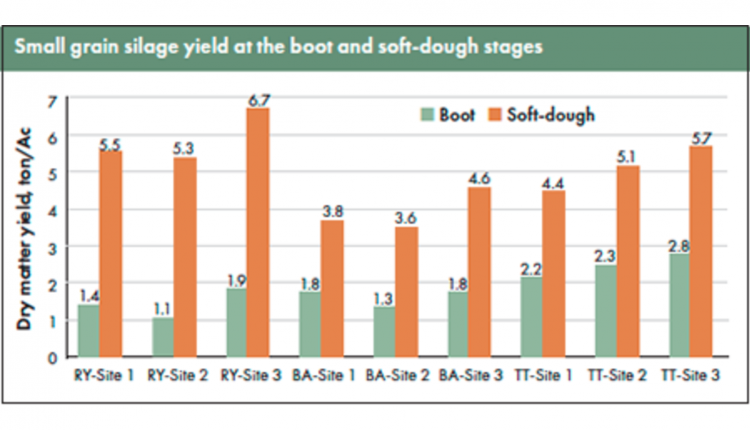The author is an associate professor, department of dairy science, Virginia Tech.
Reading about small grains for silage in the middle of the summer might seem untimely; however, a post-season evaluation of small grains for silage is always good for adjusting future management and making better decisions.
Several questions typically arise when planning small grains for silage. How can annual winter grasses fit in a double-crop rotation? What species should be planted? When should small grains be harvested?

To address these questions, we planted several winter-annual grasses in a plot study that was replicated in three different regions of Virginia. These included Blacksburg (Site 1), which is located in the Blue Ridge Mountains and has an elevation of approximately 2,000 feet (the coolest environment); Blackstone (Site 2), which is located in the Southern Piedmont region and has an elevation of approximately 450 feet (the hottest environment); and Orange (Site 3), which is located in the Northern Piedmont region and has an elevation of approximately 500 feet (an intermediate environment).
In each of these regions, we planted four varieties of triticale (TT), two varieties of rye (RY), and two varieties of barley (BA) in triplicates. All these varieties were harvested at the boot and soft-dough stage of maturity.
Heat drove maturity
As expected, it took fewer days to reach harvest time in the hottest environment and more days in the coolest environment, and this was the case for all three species. Even though the results seem obvious, it is worth highlighting that fitting double-crops in the rotation will be more challenging in cooler areas and, therefore, some additional attention is needed for species selection and harvest timing.
If the priority is to release the field early for a subsequent summer crop, then rye or barley could be the best options when harvesting at the boot stage. However, such a decision might result in lower dry matter yields (see graph). When a balance between early release of the field and dry matter yield is needed, perhaps triticale silage, harvested at the boot stage, might be the best option.
There are several harvest timing observations to highlight. The most obvious one is the difference in dry matter yield between small grains harvested at the boot stage and those harvested at the soft-dough stage (see graph). In most cases, harvesting at the soft-dough stage more than doubled the dry matter yield compared to a boot stage harvest. Therefore, if dry matter yield is a priority, then rye or triticale at the soft-dough stage might provide the best options.
If a balance between dry matter yield and early release of the field is needed, then barley becomes a more suitable option. It is worth paying attention to the short window that barley has to reach the soft-dough maturity stage. From a logistics perspective, this may be very important when large areas need to be harvested with small-scale equipment.
Price influences timing
For this project, a lot of work is still pending regarding forage quality. Economic analyses from our laboratory with data generated by Wayne Coblentz at the Dairy Forage Research Center in Wisconsin show that when commodity prices are high (as they currently are), cheaper diets can be formulated when triticale is harvested at the boot stage than when harvested at the soft-dough stage. On the other hand, when commodity prices are low, cheaper diets can be formulated when harvesting small grains at the soft-dough stage compared to the boot stage.
Our intention is to expand these chemical and economic analyses using multiple varieties within species to provide a more holistic view and interpretation of small grains management for silage. As an early assessment of forage quality based on a subjective visual appraisal, the mild drought observed in the late spring of 2021 seemed to substantially affect the forages harvested at the soft-dough stage. This was particularly evident for some rye and triticale varieties and not as much for the barley varieties that were harvested before the drought became severe.
In summary, many management options for small grain silage are available to meet the agronomic, ecologic, nutritional, and economic needs of the dairy farm. This project, which is funded by the Virginia Agricultural Council, is a collaboration with my laboratory assistant, Christy Teets, and my colleagues Wade Thomason and Katye Payne from the School of Plant and Environmental Sciences at Virginia Tech.
This article appeared in the Aug/Sept 2021 issue of Hay & Forage Grower on page 26.
Not a subscriber? Click to get the print magazine.

